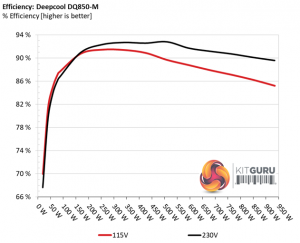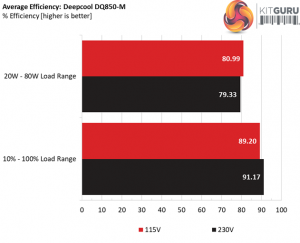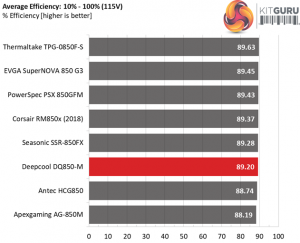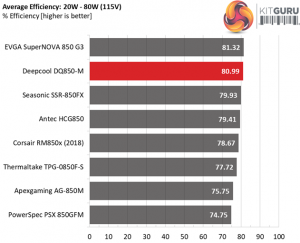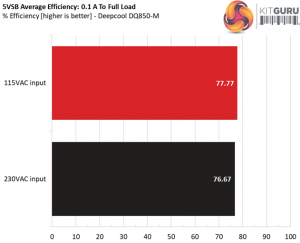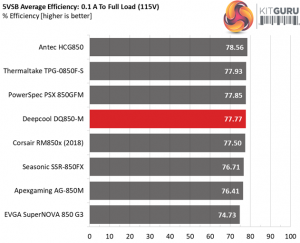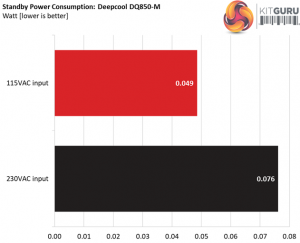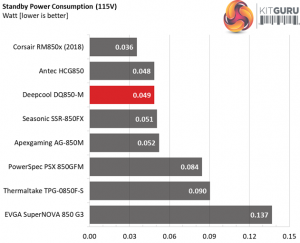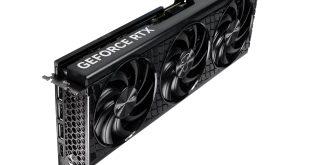Efficiency
Our efficiency testing procedure is detailed here.
Using results from the previous page, we plotted a chart showing the DQ850-M’s efficiency at low loads, and loads from 10 to 110 percent of its maximum-rated capacity.
Under normal loads the DQ850-M is close to the competition and with light loads it performs better than the majority of its opponents, losing only to the Leadex II platform of the EVGA 850 G3 model.
Efficiency At Low Loads
In the following tests, we measure the DQ850-M's efficiency at loads significantly lower than 10 percent of its maximum capacity (the lowest load the 80 PLUS standard measures). The loads we dial are 20, 40, 60, and 80W. This is important for representing when a PC is idle, with power-saving features turned on.
| Test # | 12V | 5V | 3.3V | 5VSB | DC/AC (Watts) | Efficiency | Fan Speed (RPM) | PSU Noise (dB[A]) | PF/AC Volts |
| 1 | 1.206A | 0.497A | 0.476A | 0.197A | 19.586 | 70.005% | 752 | 18.7 | 0.822 |
| 12.001V | 5.049V | 3.363V | 5.089V | 27.978 | 115.13V | ||||
| 2 | 2.468A | 0.991A | 0.980A | 0.394A | 39.933 | 81.419% | 755 | 18.7 | 0.918 |
| 12.007V | 5.047V | 3.361V | 5.084V | 49.046 | 115.12V | ||||
| 3 | 3.669A | 1.487A | 1.458A | 5.079A | 59.449 | 85.138% | 760 | 18.8 | 0.948 |
| 12.005V | 5.045V | 3.360V | 5.079V | 69.827 | 115.11V | ||||
| 4 | 4.937A | 1.982A | 1.963A | 0.788A | 79.845 | 87.400% | 750 | 18.7 | 0.965 |
| 12.002V | 5.045V | 3.359V | 5.074V | 91.356 | 115.11V |
The efficiency is kept high even under light loads, while the lack of a passive mode doesn't bother us, at all, since the cooling fan's speed and noise are kept low.
5VSB Efficiency
The ATX specification (revision 1.4), along with CEC, ErP Lot 3 2014 and ErP Lot 6 2010/2013, states that the 5VSB standby supply efficiency should be as high as possible, recommending 75 percent or higher with 550mA, 1A, and 1.5A of load.
The supply should also achieve higher than 75% efficiency at 5VSB under full load, or with 3A if its max current output on this rail is higher than 3A.
We take six measurements: one each at 100, 250, 550, 1000, and 1500mA, and one with the full load the 5VSB rail can handle.
| Test # | 5VSB | DC/AC (Watts) |
Efficiency | PF/AC Volts |
| 1 | 0.100A | 0.509 | 76.198% | 0.067 |
| 5.091V | 0.668 | 115.12V | ||
| 2 | 0.250A | 1.272 | 79.252% | 0.150 |
| 5.088V | 1.605 | 115.12V | ||
| 3 | 0.550A | 2.796 | 80.046% | 0.267 |
| 5.082V | 3.493 | 115.12V | ||
| 4 | 1.000A | 5.074 | 77.978% | 0.365 |
| 5.073V | 6.507 | 115.12V | ||
| 5 | 1.500A | 7.596 | 77.844% | 0.418 |
| 5.063V | 9.758 | 115.12V | ||
| 6 | 2.500A | 12.610 | 75.270% | 0.466 |
| 5.043V | 16.753 | 115.11V |
Typically for a high-end CWT platform, the 5VSB rail's efficiency is at good levels.
Power Consumption In Idle And Standby
In the table below, you’ll find the power consumption and voltage values of all rails (except -12V) when the PSU is idle (powered on, but without any load on its rails), and the power consumption when the unit is in standby mode (without any load, at 5VSB).
| Mode | 12V | 5V | 3.3V | 5VSB | Watts | PF/AC Volts |
| Idle | 12.001V | 5.052V | 3.362V | 5.094V | 5.809 | 0.355 |
| 115.1V | ||||||
| Standby | 0.049 | 0.005 | ||||
| 115.1V | ||||||
The power needs of this platform at standby are very low, regardless of the input voltage.
Fan RPM, Delta Temperature, And Output Noise
Our mixed noise testing is described in detail here.
The first chart below illustrates the cooling fan's speed (in RPM), and the delta between input and output temperature. The results were obtained at 37°C (98.6°F) to 47°C (116.6°F) ambient temperature.
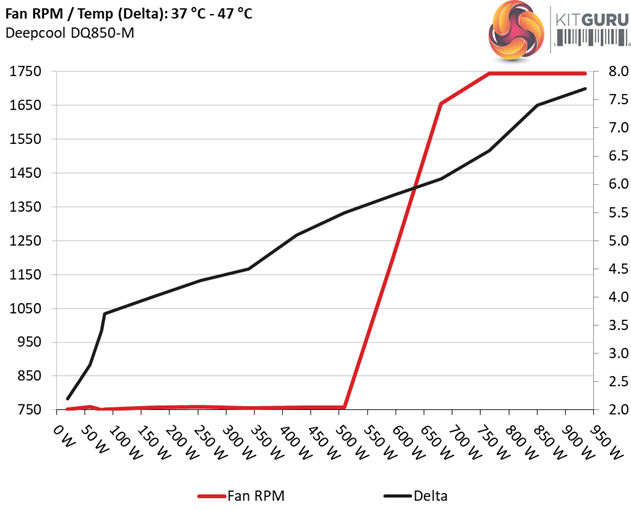
The next chart shows the cooling fan's speed (again, in RPM) and output noise. We measure acoustics from one meter away, inside a hemi-anechoic chamber. Background noise inside the chamber is below 6 dB(A) during testing (it's actually much lower, but our sound meter’s microphone hits its floor), and the results are obtained with the PSU operating at 37°C (98.6°F) to 47°C (116.6°F) ambient temperature.
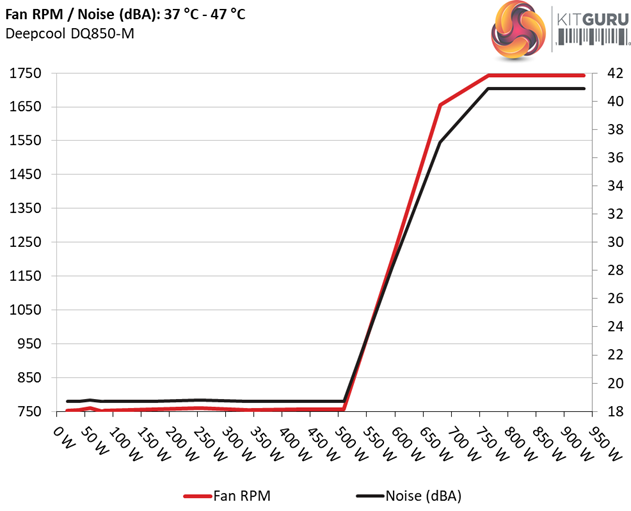 The following graph illustrates the fan's output noise over the PSU's operating range. The same conditions of the above graph apply to our measurements, though the ambient temperature is between 30°C (86°F) to 32°C (89.6°F).
The following graph illustrates the fan's output noise over the PSU's operating range. The same conditions of the above graph apply to our measurements, though the ambient temperature is between 30°C (86°F) to 32°C (89.6°F).
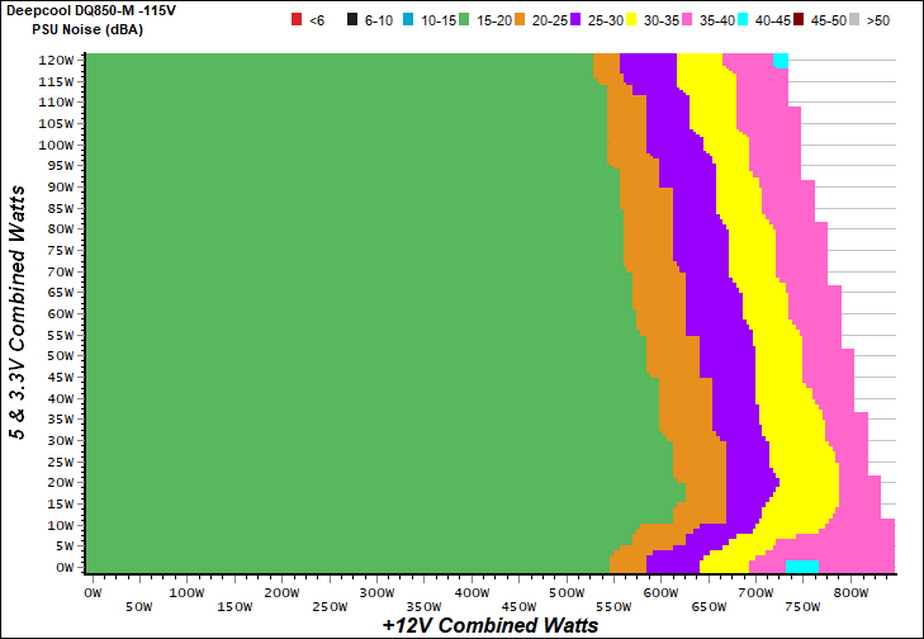
There is no passive operation but as you can see in the graph above, up to 550W (at +12V) the PSU's noise is kept very low, within the 15-20 dB(A) range. It needs about 90W more to exceed 30 dB(A) and with 695W and more it enters the 35-40 dB(A) zone. With a larger diameter fan the noise output could be even lower.
 KitGuru KitGuru.net – Tech News | Hardware News | Hardware Reviews | IOS | Mobile | Gaming | Graphics Cards
KitGuru KitGuru.net – Tech News | Hardware News | Hardware Reviews | IOS | Mobile | Gaming | Graphics Cards


